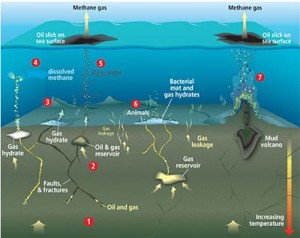A major spike in the powerful greenhouse gas methane nearly 12,000 years ago wasn’t the result of a catastrophic release of seafloor gas hydrates, researchers writing in Science this week have found.
 That’s come as a relief to concerned climate scientists, who had feared that global warming could trigger another massive release of methane into the atmosphere, compounding the impacts of climate change.
That’s come as a relief to concerned climate scientists, who had feared that global warming could trigger another massive release of methane into the atmosphere, compounding the impacts of climate change.
Analysis of a large ice sample taken from Greenland confirmed the sharp increase in methane towards the end of the last Ice Age, but suggests the methane was released from spreading wetlands rather than a sudden burst of methane trapped in seafloor deposits.
The research is based on a five-year project funded by the National Science Foundation, and other agencies and involved four researchers* from the New Zealand’s National Institute of Water & Atmospheric Research (NIWA).
Registered journalists can log into the SMC Resource Library to access the research.
The NIWA co-authors of the paper comment:
“With man-made climate change under way, scientists are concerned that warming will trigger the release of greenhouse gases currently stored in natural reservoirs. This process would cause additional warming and increase climate related risks.
“One such reservoir is the store of so-called gas hydrates or clathrates in ocean sediments, which contain methane (CH4), a potent greenhouse gas, in quantities that exceed all carbon that is stored in conventional oil and gas fields. In order to evaluate if clathrates pose a risk for our future, it is important to examine how this reservoir reacted to warming in the past, for example at the end of the last ice age when large amounts of methane were released into the atmosphere.
“To see whether this gas came from clathrates, a team of scientists from the USA, New Zealand, Denmark, Canada and Australia used a definitive test: they carbon dated ice age methane preserved in tiny air bubbles that had been trapped in a glacier in Greenland between 10,000 and 20,000 years ago. If the methane turned out to be much older than the ice it would be a sure sign that it had been at least partially derived from clathrates and consistent with the hypothesis that global warming itself could lead to the release of extra methane; a ‘positive feedback’.
“For each measurement one metric tonne of glacier ice had to be cut with chainsaws, cleaned and melted, just to yield a volume of methane smaller than the size of a sugar cube. To purify and isolate the methane extracted from the ice, new and innovative techniques had to be developed at New Zealand’s National Institute of Water and Atmospheric Research in Wellington.
“The results published in today’s Science article show that clathrates emitted very little, if any, methane to the atmosphere during the strong warming at the end of the ice age.
“Instead, wetlands spread and became more productive, releasing more methane. Only after warming had progressed and atmospheric methane levels had already risen, may clathrates have made a modest contribution to methane emissions, according to the new study. A worst case scenario where clathrate emissions triggered by man-made warming exacerbate climate change appears therefore unlikely, but other feedback effects due to global warming remain a risk.”
Dr Chris Hollis, Senior Scientist at GNS Science comments:
“Given the close correlation between methane and temperature variation through glacial-interglacial cycles of the last half million years or so, melting of sub-sea floor methane seemed a plausible cause of the rapid warmings that mark the terminations of glacial episodes.
“In fact, ex-pat New Zealander Prof James Kennett, UC Santa Barbara, published a book on the idea – called The Clathrate Gun Hypothesis. Indeed, Jim recognised that analysis of Greenland ice would provide the ultimate proof of the theory.
“As it turned out, this study disproved the theory by identifying wetlands as the source of the methane. So, the methane release is a consequence, not a cause of the warming events. Of course methane is still recognized as a contributor to global warming.
“However, the study does not disprove the general theory that under times of extreme global warmth, such as in the early Eocene 55 million years ago, the deep sea might have warmed enough to cause the catastrophic release of sub-seafloor methane.”
Dr Tim Naish, Director of the Antarctic Research Centre at Victoria University comments:
“The key outcome of this paper is that the source of that methane has been identified – wetland rather then ocean sediments.
“The idea still holds that a change in the climate system (probably an external warming) initiated methane release from (in this case wetlands/melting permafrost). The methane release then amplifies the initial warming.”
* Dave Lowe, Hinrich Schaefer, Gordon Brailsford, Katja Riedel
Further Information
To talk to these or other New Zealand experts, please contact the Science Media Centre on tel: 04 499 5476 or email: smc@sciencemediacentre.co.nz.